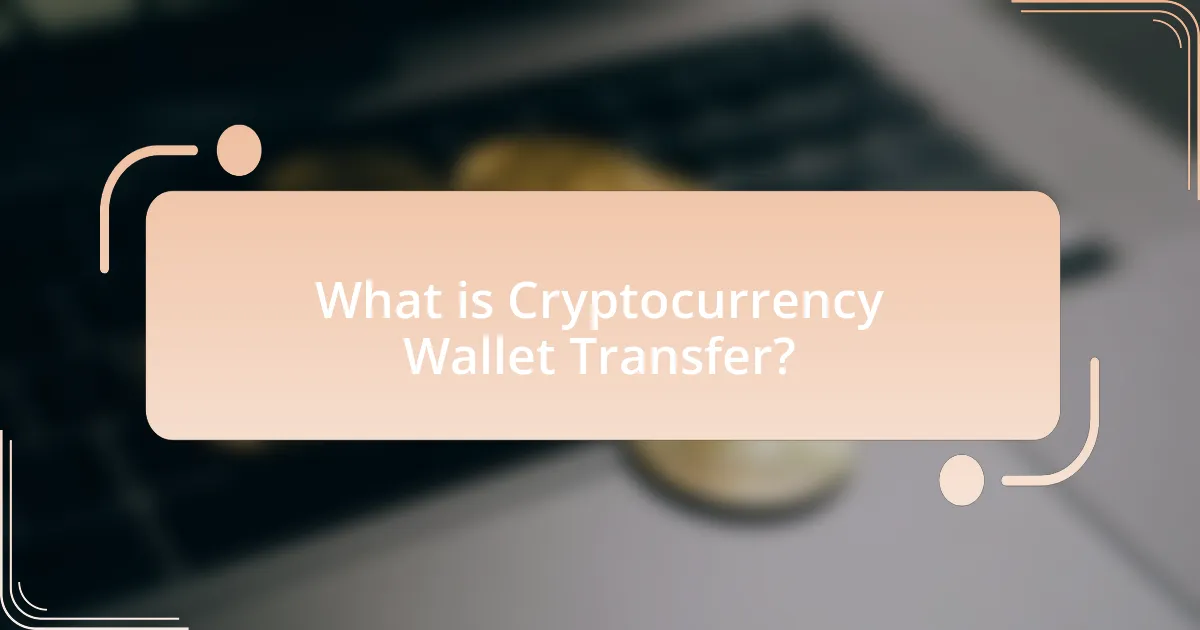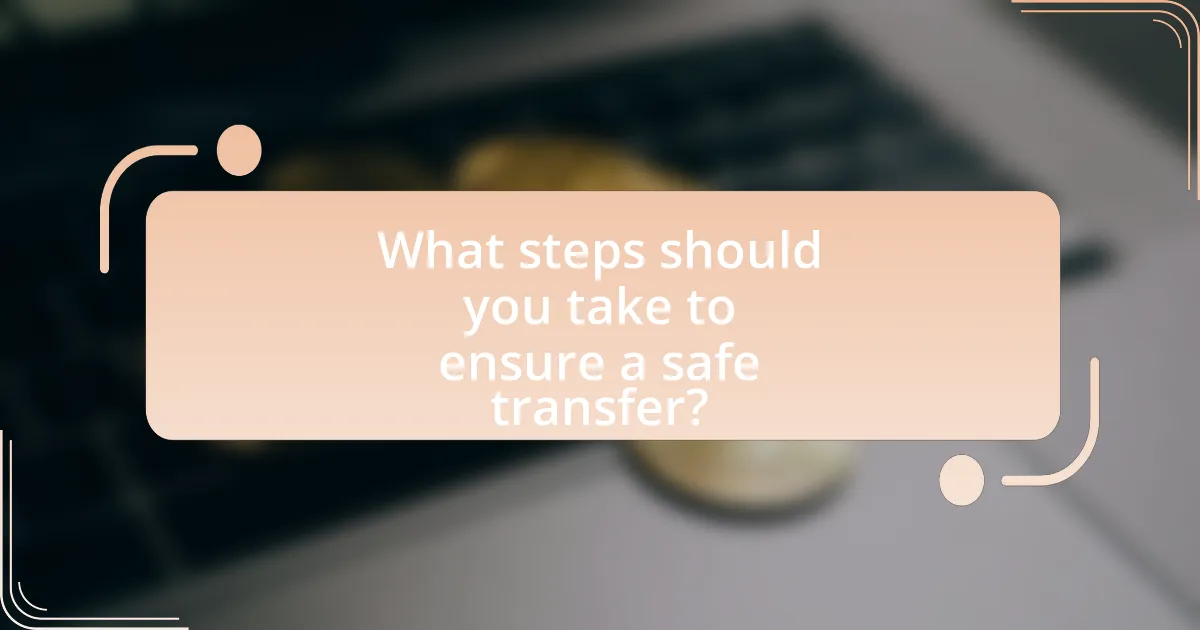Cryptocurrency wallet transfer is the process of sending digital assets between wallets using blockchain technology, which ensures secure and transparent transactions. This article outlines the mechanics of transferring cryptocurrency, including the types of wallets involved, the key processes, and the importance of safe transfers to protect assets from theft and loss. It also discusses best practices for secure transfers, such as verifying recipient addresses and enabling two-factor authentication, while highlighting common mistakes to avoid. Additionally, the article provides insights on minimizing transaction fees and troubleshooting tips for failed or delayed transfers, ensuring users can navigate the complexities of cryptocurrency transactions effectively.

What is Cryptocurrency Wallet Transfer?
Cryptocurrency wallet transfer refers to the process of sending digital assets from one cryptocurrency wallet to another. This transfer involves the use of blockchain technology, where transactions are recorded on a decentralized ledger, ensuring transparency and security. Each wallet has a unique address, and the transfer is initiated by specifying the recipient’s address and the amount to be sent. The transaction is then verified by network nodes through cryptography, and once confirmed, the funds are moved from the sender’s wallet to the recipient’s wallet. This process is fundamental to the functioning of cryptocurrencies, as it enables users to exchange assets securely and efficiently.
How does transferring cryptocurrency between wallets work?
Transferring cryptocurrency between wallets involves sending digital assets from one wallet address to another using the blockchain network. The process begins when the sender initiates a transaction by specifying the recipient’s wallet address and the amount of cryptocurrency to be transferred. This transaction is then broadcasted to the network, where it is verified by miners or validators who confirm its legitimacy through consensus mechanisms. Once verified, the transaction is added to the blockchain, making it immutable and publicly accessible.
The proof of this process lies in the decentralized nature of blockchain technology, which ensures that all transactions are recorded transparently and securely. For example, Bitcoin transactions are confirmed through a proof-of-work system, where miners solve complex mathematical problems to validate transactions, ensuring that double-spending does not occur. This verification process typically takes a few minutes, depending on network congestion and transaction fees.
What types of wallets are involved in cryptocurrency transfers?
The types of wallets involved in cryptocurrency transfers are hot wallets, cold wallets, and hardware wallets. Hot wallets are connected to the internet and facilitate quick transactions, making them suitable for frequent trading. Cold wallets, on the other hand, are offline storage solutions that provide enhanced security for long-term asset holding. Hardware wallets are a specific type of cold wallet that store private keys on a physical device, ensuring that they are not exposed to online threats. Each wallet type serves a distinct purpose in managing cryptocurrency securely during transfers.
What are the key processes in a cryptocurrency transfer?
The key processes in a cryptocurrency transfer include initiating the transaction, verifying the transaction, broadcasting the transaction to the network, and confirming the transaction on the blockchain. Initiating the transaction involves the sender specifying the recipient’s wallet address and the amount to be transferred. Verification occurs when the sender’s wallet checks for sufficient balance and validates the transaction details. Broadcasting entails sending the transaction data to the cryptocurrency network, where miners or validators receive it for processing. Finally, confirmation happens when the transaction is added to a block on the blockchain, ensuring its permanence and security. Each of these steps is crucial for a successful and secure transfer of cryptocurrency.
Why is it important to transfer cryptocurrency safely?
Transferring cryptocurrency safely is crucial to protect assets from theft and loss. The decentralized nature of cryptocurrencies makes them susceptible to hacking and fraud, with billions of dollars lost annually due to insecure transactions. For instance, in 2021 alone, over $3 billion was stolen from cryptocurrency exchanges and wallets, highlighting the need for secure transfer methods. Ensuring safe transfers minimizes the risk of unauthorized access and enhances the overall security of digital assets.
What risks are associated with unsafe cryptocurrency transfers?
Unsafe cryptocurrency transfers pose several significant risks, including loss of funds, fraud, and irreversible transactions. When transfers are conducted without proper security measures, such as using unsecured networks or failing to verify recipient addresses, users may inadvertently send funds to malicious actors or incorrect wallets. According to a report by Chainalysis, in 2021, over $7.7 billion worth of cryptocurrency was lost to scams and hacks, highlighting the prevalence of these risks. Additionally, the decentralized nature of cryptocurrencies means that once a transaction is confirmed, it cannot be reversed, leaving users with no recourse to recover lost funds.
How can safe transfers protect your assets?
Safe transfers protect your assets by ensuring that cryptocurrency transactions are conducted securely, minimizing the risk of theft or loss. Utilizing secure methods such as hardware wallets, two-factor authentication, and encrypted communication channels significantly reduces vulnerabilities during the transfer process. For instance, a study by the Blockchain Security Alliance found that 90% of cryptocurrency thefts occur due to insecure transfer practices. By adhering to safe transfer protocols, individuals can safeguard their digital assets against unauthorized access and potential financial loss.

What steps should you take to ensure a safe transfer?
To ensure a safe transfer of cryptocurrency between wallets, first verify the wallet addresses to prevent sending funds to the wrong destination. This step is crucial because sending cryptocurrency to an incorrect address can result in irreversible loss. Next, enable two-factor authentication (2FA) on your wallets to add an extra layer of security against unauthorized access. Additionally, use a secure internet connection, avoiding public Wi-Fi, as it can expose your transaction details to potential hackers. Finally, conduct a small test transfer before sending larger amounts to confirm that the transaction processes correctly. This method minimizes risk and ensures that the transfer mechanism is functioning as intended.
How do you choose the right wallet for transferring cryptocurrency?
To choose the right wallet for transferring cryptocurrency, assess the wallet’s security features, compatibility with your desired cryptocurrencies, and user interface. Security is paramount; look for wallets that offer two-factor authentication, encryption, and backup options. Compatibility is crucial as not all wallets support every cryptocurrency; ensure the wallet can handle the specific coins you intend to transfer. A user-friendly interface enhances the experience, especially for beginners, making it easier to navigate transactions. According to a 2021 survey by Statista, 40% of cryptocurrency users prioritize security features when selecting a wallet, highlighting the importance of these criteria in making an informed choice.
What features should you look for in a secure wallet?
A secure wallet should have features such as strong encryption, two-factor authentication, and a user-friendly interface. Strong encryption protects the wallet’s data from unauthorized access, while two-factor authentication adds an extra layer of security by requiring a second form of verification. A user-friendly interface ensures that users can easily navigate the wallet without compromising security. Additionally, features like backup and recovery options, multi-signature support, and regular software updates further enhance the wallet’s security, making it resilient against potential threats.
How do different wallet types affect transfer safety?
Different wallet types significantly affect transfer safety due to their varying levels of security features and vulnerability to attacks. Hardware wallets, for instance, store private keys offline, making them less susceptible to hacking compared to software wallets, which are connected to the internet and can be compromised through malware or phishing attacks. According to a report by the Cybersecurity and Infrastructure Security Agency, hardware wallets are considered one of the safest options for storing cryptocurrencies because they provide a secure environment for transactions. Conversely, mobile and web wallets, while convenient, often lack robust security measures, increasing the risk of unauthorized access and loss of funds. Thus, the choice of wallet type directly influences the safety of cryptocurrency transfers.
What precautions should you take before initiating a transfer?
Before initiating a transfer, ensure you verify the recipient’s wallet address to prevent sending funds to the wrong destination. Double-checking the address is crucial, as cryptocurrency transactions are irreversible; sending to an incorrect address can result in permanent loss of funds. Additionally, confirm that the wallet you are transferring to supports the specific cryptocurrency being sent, as compatibility issues can lead to failed transactions. Always use a secure internet connection to avoid potential interception by malicious actors, and consider enabling two-factor authentication on your accounts for added security.
How can you verify the recipient’s wallet address?
To verify the recipient’s wallet address, you should cross-check the address with the sender or use a blockchain explorer. Cross-checking involves confirming the address directly with the person or entity you are sending cryptocurrency to, ensuring it matches exactly. Using a blockchain explorer allows you to input the wallet address and view its transaction history, confirming its validity and activity. This method is supported by the fact that blockchain explorers provide real-time data on wallet addresses, making it a reliable tool for verification.
What security measures should you implement before transferring?
Before transferring cryptocurrency, implement two key security measures: enable two-factor authentication (2FA) and verify wallet addresses. Enabling 2FA adds an extra layer of security by requiring a second form of identification, significantly reducing the risk of unauthorized access. According to a study by Google, accounts with 2FA are 100% more secure against phishing attacks. Additionally, verifying wallet addresses ensures that funds are sent to the correct destination, as a single character error can lead to irreversible loss of assets. The Blockchain.info report indicates that 20% of cryptocurrency transactions are sent to incorrect addresses, highlighting the importance of this measure.

What are the best practices for transferring cryptocurrency?
The best practices for transferring cryptocurrency include using secure wallets, verifying recipient addresses, enabling two-factor authentication, and keeping software updated. Secure wallets, such as hardware wallets, protect assets from hacks, while verifying recipient addresses prevents sending funds to incorrect or malicious addresses. Enabling two-factor authentication adds an extra layer of security, and keeping software updated ensures protection against vulnerabilities. According to a report by Chainalysis, 70% of cryptocurrency thefts occur due to poor security practices, highlighting the importance of these measures.
How can you minimize fees during a cryptocurrency transfer?
To minimize fees during a cryptocurrency transfer, choose a network with lower transaction fees and time your transfers during off-peak hours. For instance, Ethereum’s gas fees can fluctuate significantly based on network congestion; transferring during times of lower activity can reduce costs. Additionally, using layer-2 solutions or alternative blockchains with lower fees, such as Binance Smart Chain or Polygon, can further decrease expenses. Research indicates that transaction fees on these platforms can be significantly lower than those on Ethereum during peak times, often by over 90%.
What factors influence transaction fees in cryptocurrency transfers?
Transaction fees in cryptocurrency transfers are primarily influenced by network congestion, transaction size, and the specific cryptocurrency being used. Network congestion occurs when many users are attempting to make transactions simultaneously, leading to higher fees as users compete to have their transactions processed quickly. Transaction size, measured in bytes, affects fees because larger transactions require more data to be processed, thus incurring higher costs. Additionally, different cryptocurrencies have varying fee structures; for example, Bitcoin typically has higher fees during peak times compared to Ethereum, which uses a different mechanism for calculating fees based on gas prices. These factors collectively determine the cost of executing a transaction on the blockchain.
How can timing affect transfer costs?
Timing significantly affects transfer costs in cryptocurrency transactions due to network congestion and transaction fees. During periods of high demand, such as market surges or significant news events, the number of transactions increases, leading to higher fees as users compete to have their transactions processed quickly. For example, during the 2017 Bitcoin bull run, average transaction fees surged to over $50 due to network congestion. Conversely, transferring during off-peak times can result in lower fees, as the network is less congested and miners are more likely to accept lower fees. Thus, timing can directly influence the cost-effectiveness of transferring cryptocurrency between wallets.
What common mistakes should you avoid when transferring cryptocurrency?
When transferring cryptocurrency, common mistakes to avoid include sending to the wrong address, neglecting to double-check transaction fees, and failing to use secure networks. Sending to an incorrect address can result in irreversible loss of funds, as blockchain transactions are permanent. Neglecting transaction fees may lead to delays in processing, as lower fees can result in slower confirmations. Additionally, using unsecured networks increases the risk of interception by malicious actors, potentially compromising your private keys or wallet information.
How can sending to the wrong address impact your transfer?
Sending cryptocurrency to the wrong address can result in the permanent loss of funds. When a transfer is initiated, the transaction is recorded on the blockchain, and if the address is incorrect, the cryptocurrency is sent to a non-existent or unintended wallet. This means that the sender cannot retrieve the funds, as blockchain transactions are irreversible. According to a report by Chainalysis, over $10 billion worth of cryptocurrency was lost due to user errors, including sending to incorrect addresses. Thus, ensuring the accuracy of the recipient’s address is crucial for safeguarding assets during cryptocurrency transfers.
What are the consequences of ignoring network congestion?
Ignoring network congestion can lead to significant delays in transaction processing, resulting in failed or unconfirmed cryptocurrency transfers. When congestion occurs, transactions may take longer to be included in a block, which can cause users to miss time-sensitive opportunities or incur higher fees to expedite their transactions. According to data from blockchain analytics firms, during peak congestion periods, transaction fees can increase by over 200%, making it costly for users to complete transfers. Additionally, prolonged congestion can lead to a loss of trust in the network’s reliability, potentially driving users to seek alternative platforms for their cryptocurrency transactions.
What troubleshooting tips can help if a transfer goes wrong?
If a cryptocurrency transfer goes wrong, first verify the transaction details, including the recipient’s wallet address and the amount sent. Ensuring accuracy in these details can prevent common errors. Next, check the transaction status on the blockchain explorer to confirm whether the transaction was processed or is pending. If the transaction is pending, it may be due to network congestion, and waiting may resolve the issue. Additionally, if the transaction failed, review any error messages provided by the wallet service for specific guidance. If necessary, contact the wallet provider’s support team for assistance, as they can offer insights based on their system’s logs and transaction history.
How can you track a cryptocurrency transfer?
You can track a cryptocurrency transfer by using the blockchain explorer associated with the specific cryptocurrency. Blockchain explorers allow users to input the transaction ID or wallet address to view transaction details, including the status, amount, and confirmation count. For example, Bitcoin transactions can be tracked using explorers like Blockchair or Blockchain.com, which provide real-time data on transactions recorded on the Bitcoin blockchain. This method is reliable because all transactions are publicly recorded on the blockchain, ensuring transparency and traceability.
What steps should you take if a transfer fails or is delayed?
If a transfer fails or is delayed, first verify the transaction status on the blockchain using a block explorer to confirm whether it was processed. If the transaction is unconfirmed, wait for a reasonable period, as delays can occur due to network congestion. If the transaction is confirmed but not reflected in the recipient’s wallet, contact the wallet provider’s support for assistance. Additionally, ensure that the recipient’s wallet address was entered correctly, as errors can lead to lost funds. According to blockchain data, transaction times can vary significantly based on network traffic, with delays sometimes exceeding an hour during peak times.